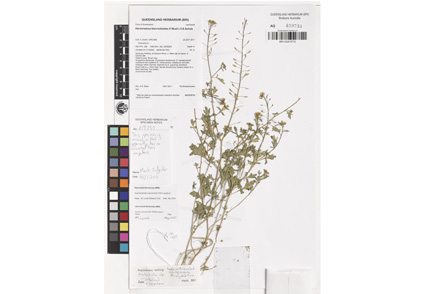Abstract
The taxonomic limits of Arabidella, Cuphonotus, and Lemphoria (Brassicaceae, Microlepidieae) are revised based on a critical evaluation of morphology in light of recent cytogenomic and molecular phylogenetic findings. As a result, Lemphoria is re-established to include two species previously placed in Cuphonotus and two in Arabidella. Lemphoria queenslandica is described as a new species, and the new combinations L. andraeana, L. eremigena, L. humistrata, and L. procumbens are proposed. Keys to distinguish Arabidella and Lemphoria species and an expanded generic description of Lemphoria are provided.
References
Heenan, P.B., Goeke, D.F., Houliston, G.J. & Lysak, M.A. (2012) Phylogenetic analyses of ITS and rbcL DNA sequences for sixteen genera of Australian and New Zealand Brassicaceae result in the expansion of the tribe Microlepidieae. Taxon 61: 970–979. https://doi.org/10.1002/tax.615004
Hewson, H.J. (1982) Brassicaceae. In: Briggs, B.G., Barlow, B.A., Eichler, H., Pedley, L., Ross, J., H., Symon, D.E. & Wilson, P.G. (Eds.) Flora of Australia, vol. 8. Australian Government Publishing Service, Canberra, 420 pp.
Hooker, J.D. (1867) Handbook of the New Zealand flora: a systematic description of the native plants of New Zealand and the Chatham, Kermadec’s, Lord Auckland’s, Campbell’s and Macquarrie’s Islands, part 2. Reeve & Co, London, pp. 393–798. https://doi.org/10.5962/bhl.title.132966
Mandáková, T., Joly, S., Krzywinski, M., Mummenhoff, K. & Lysak, M.A. (2010a) Fast diploidization in close mesopolyploid relatives of Arabidopsis. The Plant Cell 22: 2277– 2290. https://doi.org/10.1105/tpc.110.074526
Mandáková, T., Heenan, P.B. & Lysak, M.A. (2010b) Island species radiation and karyotypic stasis in Pachycladon allopolyploids. BMC Evolutionary Biology 10: 1–14. https://doi.org/10.1186/1471-2148-10-367
Mandáková, T., Pouch, M., Harmanova, K., Zhan, S.H., Mayrose, I. & Lysak, M.A. (2017) Multispeed genome diploidization and diversification after an ancient allopolyploidization. Molecular Ecology 26: 6445–6462. https://doi.org/10.1111/mec.14379
Mueller, F.J.H.von (1853) Diagnoses et descriptions plantarum Novarum, quas in Nova Hollandia australi praecipua in regionibus interioribus. Linnaea 25: 367–445.
Mueller, F.J.H. von (1861) Fragmenta Phytographiae Australiae, vol. 2. Government Printer, John Ferres, Melbourne, 199 pp.
Mueller, F.J.H. von (1878) Fragmenta Phytographiae Australiae, vol. 11. Government Printer, John Ferres, Melbourne, 151 pp.
Mueller, F.J.H. von (1885) Definitions of some new Australian plants. The Southern Science Record and Magazine of Natural History, n. ser. 1: 49–50.
Schulz, O.E. (1924) Cruciferae-Sisymbrieae. In: Engler, A. (Ed.) Pflanzenreich IV. 105 (Heft 86). Verlag von Wilhelm Engelmann, Leipzig, 388 pp.
Schulz, O.E. (1933) Kurze Notizen über neue Gattungen, Sektionen und Arten der Cruciferen. Botanische Jahrbücher fur Systematic Pflanzengeschichte und Pflanzengeographie 66: 91– 102.
Shaw, E.A. (1965) Taxonomic revision of some Australian endemic genera of Cruciferae. Transactions of the Royal Society of South Australia 89: 145–253.
Shaw, E.A. (1974) Revisions of some genera of Cruciferae native to Australia. Contributions from the Gray Herbarium of Harvard University 205: 147–162.
Tate, R. (1885) Descriptions of new species of South Australian plants. Transactions and Proceedings and Report of the Royal Society of South Australia 7: 67–71.
Warwick, S.I., Mummenhoff, K., Sauder, C.A., Koch, M.A. & Al-Shehbaz, I.A. (2010) Closing the gaps: Phylogenetic relationships in the Brassicaceae based on DNA sequence data of nuclear ribosomal ITS. Plant Systematics and Evolution 285: 209–232. https://doi.org/10.1007/s00606-010-0271-8
Zuo, S., Guo, X., Mandáková, T., Edginton, M., Al-Shehbaz, I.A. & Lysak, M.A. (2022) Genome diploidization associates with cladogenesis, trait disparity and plastid gene evolution in a crucifer tribe. Plant Physiology. [conditionally accepted] https://doi.org/10.1093/plphys/kiac268


